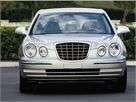Recent Articles
Popular Makes
Body Types
2004 Kia Amanti Review
What is luxury?

When discussing automobiles, what defines luxury? Is luxury a function of design, a function of convenience, a function of feature count, a function of price, a function of brand, a function of marketing? Is a standard Mercedes-Benz C230 Sport Coupe without options a luxury car simply because it wears a three-pointed star on its grille? Is the only thing excluding a fully equipped Toyota Camry XLE V6 from the entry-luxury club the badge that it shares with a Toyota Echo?
Traditional notions of what constitutes a luxury car have fragmented over recent decades. There was a time when luxury could be defined by the brand name a car wore and the styling of the interior and exterior – a Cadillac and a Pontiac would never be confused with one another, and the Cadillac was obviously the luxurious automobile. But today, the lines aren’t as clearly drawn. Case in point: the Cadillac CTS and the Pontiac Bonneville GXP.
Furthermore, the market is segmenting itself into specific niches like never before and this record proliferation of vehicles, combined with advances in technology and engineering, is producing models that can be considered of premium quality compared to other cars in the class, if not quite reaching the level of luxury. Illustrating this phenomenon are the feature-laden and stoutly engineered premium compact cars that are starting to flood North America. The Mercedes-Benz C230 Sport Coupe is a perfect example, as is the Mazda 3.
Additionally, auto manufacturers once defined as luxury brands are reaching down and producing less expensive vehicles that younger people can afford in an effort to capture consumers at a earlier age. Other car builders formerly restricted to the lower echelons of the market are building bigger and better equipped vehicles to satisfy the needs of brand-loyal buyers who want to move up as they age and become financially successful. The result is that consumers are cross-shopping between the traditional luxury and non-luxury brands more often than ever before.
Therefore, luxury can no longer be defined simply by brand. With Mercedes reaching down, Toyota reaching up, and monkey-in-the-middle marques like Buick, Chrysler and Mercury unsure of their stature in the world, new premium segments are sprouting like Chinese millionaires. Logically, a $23,000 Acura RSX cannot be justified as a luxury car any more than a $33,000 Chrysler 300C can be simply labeled a full-size sedan. Rather, these are premium automobiles, the Acura offering a little something more than the run-of-the-mill sport hatch, the Chrysler offering added value compared to the traditional three-box family sedan.
Which brings us to the subject of our road test: the 2004 Kia Amanti. Like it or not, this is a premium automobile. But as we learned during a weeklong test drive, it achieves this status primarily through style and not substance.
Kia wants the 2004 Amanti to buck the large sedan trend toward plain and uninspiring design by offering distinctive styling, more amenities, and a lower than expected price tag. Room, comfort and safety were the company’s top goals with the Amanti, with the hoped-for side benefit of erasing notions that Kia is all about entry-level economy cars. The target market for the 2004 Kia Amanti is white-collar managerial men in their late 40s and 50s, married, college-educated, and with a household income of $60,000 to $80,000 annually.
Based on our time behind the wheel of the 2004 Kia Amanti, we’d say that the company has achieved its primary goals. Viewed from a comfort and convenience perspective, the Amanti finds success, but after traveling several hundred miles over a wide variety of road surfaces in Southern California, we’d rate the Amanti a dud, dynamically.
The 2004 Kia Amanti’s powertrain package is standard-issue: a 3.5-liter V6 engine drives the front wheels through an automatic transmission. Far from a technological marvel, as evidenced by the disappointing power output, this 3.5-liter V6 is charged with motivating a car that weighs more than two tons and generates just 195 horsepower at 5,500 rpm and 217 lb.-ft. of torque at 3,500 rpm. Notably, the automatic transmission offers five forward gears rather than four, and includes a Sportmatic manual shift gate that is likely to be used infrequently by Amanti owners. Impressively, Kia provides a warranty that covers the engine and transmission for ten years or 100,000 miles, whichever comes first.
Underpinning this new Kia is a four-wheel-independent suspension comprised of a double-wishbone design in front and a multi-link arrangement at the rear; gas shocks and stabilizer bars are included at both ends of the Amanti. Power rack-and-pinion steering guides the 16-inch alloy wheels and P225/60 Hankook Optimo tires, while four-wheel-disc brakes, vented in front and equipped with ABS and electronic brake force distribution, scrub speed.